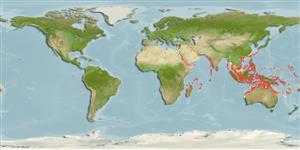Common names from other countries
Environment: milieu / climate zone / depth range / distribution range
Ecología
Asociado a arrecife; rango de profundidad 3 - 56 m (Ref. 8294). Tropical; 30°N - 27°S, 32°E - 172°W (Ref. 848)
Distribución
Países | Áreas FAO | Ecosistemas | Ocurrencias, apariciones | Introducciones
Indo-West Pacific: Bonin Islands to Australia and Red Sea to Kiribati.
Length at first maturity / Tamaño / Peso / Age
Maturity: Lm ? range ? - ? cm
Maximum depth from Ref. 100940. In Palau, it has variable bleaching level and distinct variation in color upon bleaching (Ref. 66144).
Life cycle and mating behavior
Madurez | Reproducción | Puesta | Huevos | Fecundidad | Larva
Mature gametes are shed into the coelenteron and spawned through the mouth. Life cycle: The zygote develops into a planktonic planula larva. Metamorphosis begins with early morphogenesis of tentacles, septa and pharynx before larval settlement on the aboral end (Ref. 833).
Ross, M.A. and G. Hodgson. 1981. (Ref. 8294)
IUCN Red List Status (Ref. 130435)
CITES status (Ref. 108899)
Not Evaluated
Human uses
| FishSource |
Herramientas
Más información
Age/SizeCrecimientoLength-weightLength-lengthMorfologíaLarvaAbundancia
Fuentes de Internet
Estimates based on models
Preferred temperature
(Ref.
115969): 25.4 - 29.3, mean 28.5 (based on 3105 cells).
Price category
Unknown.
